Brands History
The History of Seiko
Seiko, a renowned Japanese watchmaker founded in 1881, has left an indelible mark on the watch industry. Renowned for innovation and precision, Seiko has played a pivotal role in shaping horological advancements. Its contributions, including the introduction of quartz technology and the first quartz wristwatch, have positioned Seiko as a global leader. With a commitment to quality craftsmanship, Seiko continues to be a driving force in the watch industry, blending tradition with cutting-edge technology.
The Origins of Seiko
Seiko’s origins trace back to 1881 when Kintaro Hattori established a clock and jewelry shop in Tokyo. Initially focused on repairing and selling timepieces, Hattori’s dedication to precision laid the foundation for Seiko’s future success. In 1892, the company evolved into the Seikosha factory, marking a pivotal moment as it transitioned from a retail establishment to a dedicated watch production hub, setting the stage for Seiko’s growth as a pioneering watchmaker.
Milestones and Innovations
Seiko’s journey is marked by significant milestones and innovations. In 1913, they introduced the Laurel, marking their entry into wristwatch production. A defining moment occurred in 1969 with the launch of the Astron, the world’s first production Japanese quartz wristwatch, revolutionizing timekeeping. The 1960s-1970s saw Seiko’s pioneering work in quartz technology, shaping the industry. Notably, in 1986, Seiko introduced the groundbreaking kinetic watch, the Seiko Auto-Quartz, showcasing their commitment to merging traditional craftsmanship with cutting-edge advancements.
Impact on the Watch Industry
Seiko has significantly impacted the watch industry, challenging the Swiss-dominated landscape. Their pioneering role in popularizing quartz watches during the Quartz Crisis reshaped the market dynamics and posed a formidable challenge to traditional mechanical watches. Seiko’s commitment to innovation expanded beyond technology, leading them into diverse watch segments, including luxury and sports watches, further solidifying their influence on global horology.
Seiko’s Legacy
Seiko’s legacy is synonymous with a lasting reputation for precision, quality, and durability. Renowned for technological prowess, Seiko holds numerous patents reflecting its commitment to innovation. Iconic watch collections such as the Seiko 5, Grand Seiko, and Prospex showcase the brand’s diverse offerings, each embodying excellence in design and functionality. This enduring legacy positions Seiko as a stalwart in the watchmaking world, celebrated for its timeless craftsmanship and groundbreaking contributions.
Seiko Today
Seiko continues to be a prominent force in the watch industry with diverse product lines, including Seiko 5, Grand Seiko, and Prospex, catering to various preferences. Their global market presence remains strong, reflecting a blend of tradition and innovation. Seiko’s commitment to technological advancement persists, exemplified by their exploration of new materials and precision engineering. Notable collaborations, such as partnerships with renowned designers and sports events, showcase Seiko’s dynamic approach, ensuring relevance and leadership in the contemporary watch market.
Conclusion
In conclusion, Seiko’s rich history, marked by innovation and precision, has significantly shaped the watch industry. From pioneering quartz technology to iconic collections, Seiko’s legacy is a testament to its enduring commitment to craftsmanship. As we look towards the future, the anticipation for Seiko’s continued leadership in the watch world is palpable, with a commitment to innovation and diverse offerings. I encourage readers to explore and appreciate Seiko’s timepieces, each telling a story of craftsmanship and technological excellence that transcends time.





